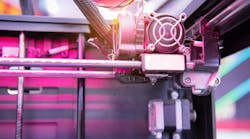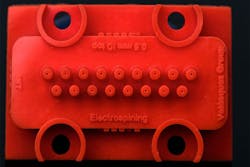Engineers at the Massachusetts Institute of Technology have used 3D printing to build a nozzle that is used to create high-quality, low-cost nanofiber meshes. Such meshes have a wide range of potential applications, including tissue engineering, water filtration, solar cells, and even body armor. But their commercialization has been hampered by inefficient manufacturing techniques.
The previous manufacturing technique, also developed at MIT, relied on an emitter etched into silicon through a complex process that required an airlocked “clean room.” The new emitter that replaces it was built using a $3,500 commercial 3-D printer.
The earlier emitter was “externally fed,” so an electric field drew a polymer solution up its sides. Fluid flow was regulated by rectangular columns etched into the sides of the emitters. However, it ultimately proved erratic, with the end result being that fibers had a wide range of diameters and the mesh was inconsistent.
The new emitter consists of an array of small nozzles; a pump pushes a fluid containing polymer particles up to them. This puts it in the category of microfluidic devices.
The new emitters are also “internally fed”: They have holes bored through them, and hydraulic pressure pushes fluid into the bores until they’re filled. Only then does an electric field draw the fluid out into tiny fibers.
Beneath the emitters, channels that feed the bores are wrapped into coils, and they gradually taper along their length. That taper is critical to regulating the diameter of the nanofibers, something that would be virtually impossible with the previous clean-room fabrication techniques.
The nozzles are arranged into two rows which are slightly offset from each other. That’s because the device was engineered to output aligned nanofibers—nanofibers that preserve their relative position as they’re collected by a rotating drum. Aligned nanofibers are particularly useful in some applications, such as tissue scaffolding. For applications in which unaligned fibers are adequate, the nozzles could be arranged in a grid, increasing the output rate.
“My opinion is that in the next few years, nobody is going to be doing microfluidics in the clean room,” says Luis Fernando Velásquez-García, a principal research scientist in MIT’s Microsystems Technology Laboratories and senior author on the new paper. “There’s no reason to do so. 3D printing can do it so much better, with better choice of materials, with the possibility to really make the structure you would like to make.
“When you go to the clean room, many times you sacrifice the geometry you want to make,” he adds. “And the second problem is that it is incredibly expensive.”
Nanofibers are useful for applications that benefits from a high ratio of surface area to volume, such as solar cells (which try to maximize exposure to sunlight) or fuel cell electrodes (which catalyze reactions at their surfaces). Nanofibers can also be permeable only at small scales, such as water filters, or remarkably tough for their weight, as in the case of body armor.
Most such applications depend on fibers with regular diameters. “The performance of the fibers strongly depends on their diameters,” Velásquez-García explains. “If you have a significant spread, what that really means is that only a few percent are really working. For example: If you have a filter, and the filter has pores between 50 nanometers and 1 micron, that’s really a 1-micron filter.”
Besides cost and design flexibility, 3D printing can also be used to rapidly test and revise designs. With this group’s microfabricated emitter, it typically takes two years to go from theoretical modeling to a published paper, and in the interim, the team might be able to test two or three variations on their basic design. With the new emitter, the process took closer to a year, and the team tested 70 iterations of the design.
“A way to deterministically engineer the position and size of electrospun fibers lets you think about controlling mechanical properties of materials made from these fibers,” says Mark Allen, the Alfred Fitler Moore Professor at the University of Pennsylvania, with joint appointments in electrical and systems engineering and mechanical engineering and applied mechanics. “It lets you think about preferential cell growth along particular directions in the fibers, and there are lots of good potential opportunities there.
“I anticipate that somebody’s going to take this technology and use it in very creative ways,” Allen continues. “If you have the need for this type of deterministically engineered fiber network, I think it’s an elegant way to achieve that goal.”



